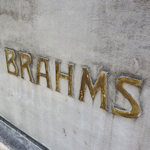
No great composer in Vienna escapes the bindings of human existence without a suitable memorial paying tribute to their prowess. And so it is with Johannes Brahms. His monument sits on Karlsplatz, close to the Musikverein concert venue where two of his symphonies premiered.
- Large stone monument sculpted by Rudolf Weyr
- Unveiled in 1908
- Central location closely tied up with Brahms’ life and work
- See also:
“One of us”

(The monument in full)
A Brahms monument committee began collecting funds soon after the composer’s death in 1897 and even received support from an initiative in England (with a William Shakespeare among the donors!).
The famous German artist, Max Klinger, took part in the bidding process for the contract but his design failed to impress the committee. Instead, local sculptor Rudolf Weyr (1847-1914) got the nod.
(No need to feel sorry for Klinger: the Brahms monument in Hamburg is one of his works.)
Weyr’s sculptures appear in many other locations in Vienna. For example, he created statues, reliefs and similar for some of the prestigious buildings put up around the Ringstrassen in the late 19th century.
All good things take time, of course, and Weyr’s monument was eventually unveiled on a rainy May 7th, 1908, around 11 years after Brahms’ death on what would have been the composer’s 75th birthday.

(Unveiling of the Brahms monument on Karlsplatz on May 7th, 1908: speech by Baron von Weckbecker to Deputy Mayor Neumayer, 1908; published by R.Lechner (Wilh. Müller); Wien Museum Inv.-Nr. 33389/2; excerpt reproduced with permission under the terms of the CC0 licence)
According to newspaper reports of the time, thousands of people visited on that first day, many leaving flowers and wreaths.
At the unveiling, the president of the monument committee gave a short speech in honour of Brahms, and also declared him:
One of us
…another great composer adopted by Vienna and who, in turn, adopted the city as his home and workplace.
The marble monument features a bearded and seated Brahms, deep in contemplation. On the wider stone plinth below lies the mythological Euterpe reaching for her lyre.

(Euterpe with her instrument)
The choice of Euterpe is no coincidence. This daughter of Zeus is the muse of music and lyrical poetry, so she presumably accompanied Brahms on his compositional journeys.
The choice of the park at Karlsplatz as a location makes a lot of sense, too.
After his permanent move to Vienna, Brahms lived on Karlsgasse (about a 2 minute walk away), and his funeral procession collected in front of the Karlskirche church that dominates one end of the park.
The stone Brahms also has an excellent view across the road to the Musikverein concert venue. He was artistic director of the Musikverein for three years, and his long association with the organisation and venue eventually led to the renaming of one of the concert halls as the Brahms-Saal in 1937.

(The man. The legend. The beard)
Another musician has an unexpected memorial on Karlsplatz. A commemorative plaque for Vivaldi hangs on the corner of the Technical University that faces Karlskirche.
(Somewhat unexpectedly, the Italian composer is buried somewhere underneath the university buildings.)
How to get to the Brahms monument
Any object of interest on Karlsplatz has the good fortune to be located above one of Vienna’s main subway stations.
Subway: the U1, U4 and U2 lines all come together at Karlsplatz. Look for the Resselpark exit from the main underground concourse.
Tram / bus: the monument sits at the centre of a square of tram stops. So you have Oper/Karlsplatz (1, 2, D, 62 and 71), Schwarzenbergplatz (2, 71, D), Gußhausstraße (D), and Resselgasse (1, 62)
Address: Karlsplatz 12, 1010 Vienna